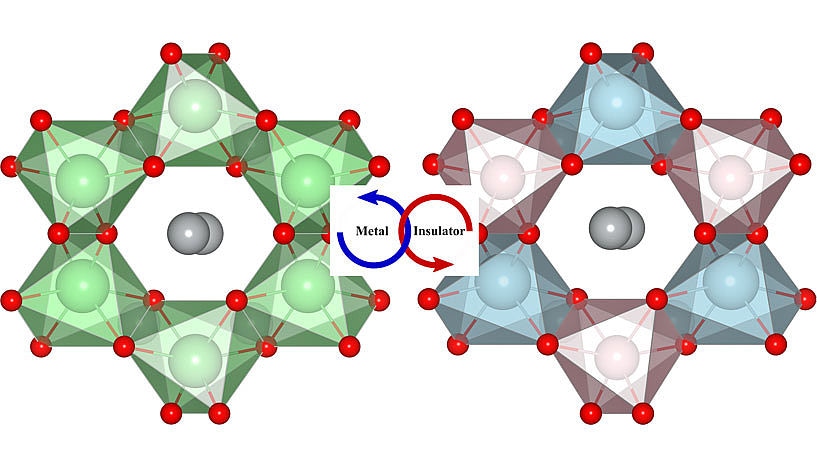Feb 9 2018
Materials that have controllable quantum mechanical characteristics are highly significant for the quantum computers and electronics in future. Discovery or development of practical materials having these features is very difficult.
At present, an international theory and computational team headed by Cesare Franchini at the University of Vienna has discovered that some quantum interactions can exist simultaneously in a single real material and demonstrated the way these interactions are controlled by using an electric field. The outcomes of the study have been reported in the Nature Communications journal.
 The application of an electric field changes the symmetry of the crystal and drives a transition from a metal (left) to an insulator (right). (Image credit: He/Franchini)
The application of an electric field changes the symmetry of the crystal and drives a transition from a metal (left) to an insulator (right). (Image credit: He/Franchini)
Next-generation quantum computers and electronics are dependent on materials that reveal quantum-mechanical phenomena and related properties, which can be regulated using external stimuli, for example, by using a battery in a microelectronic circuit. For instance, quantum mechanics controls whether and at what speed electrons can travel through a material and, hence, govern whether it is a metal conducting electric current or an insulator that does not. Moreover, the interaction between the electrons and the crystal structure directs the ferroelectric properties of a material. Here, when an external electric field is applied, switching between two electric orientations becomes possible. The probability of activating several quantum-mechanical characteristics in a single material is of scientific interest, but it can also increase the spectrum of prospective applications.
A group of international researchers (headed by Professor Cesare Franchini and Dr. Jiangang He from the Quantum Materials Modelling Group - University of Vienna, in collaboration with Professor Rondinelli from Northwestern University and Professor Xing-Qiu Chen from the Chinese Academy of Science) have shown that multiple quantum interactions can exist side-by-side in a single material and that it is feasible to switch between them by applying an electric field.
This is like awakening different kinds of quantum interactions that are quietly sleeping in the same house without knowing each other.
Professor Franchini
In order to achieve this, the researchers solved the relativistic form of the Schrödinger equation, by carrying out computer simulations on the Vienna Scientific Cluster. The material selected by the researchers, Ag2BiO3, is extraordinary because, first, it is made up of bismuth; a weighty element, which enables the spin of the electron to interact with its own motion. This process is known as spin-orbit coupling - a characteristic with no analogy in classical physics. Secondly, inversion symmetry is not exhibited by its crystal structure, indicating that ferroelectricity could occur.
Harmonizing multiple quantum mechanical properties which often do not coexist together and trying to do it by design is highly complex.
Professor Rondinelli
When an electric field is applied to the Ag2BiO3 oxide, the atomic positions change and it can be determined whether the spins are coupled in pairs, developing Weyl-fermions, or separated (Rashba-splitting) and whether the material can conduct electric current.
We have found the first real case of a topological quantum transition from a ferroelectric insulator to a non-ferroelectric semi-metal.
Professor Franchini
The spin-orbit coupling is of fundamental significance as it enables the emergence of innovative quantum states of matter, and depicts one of the intriguing research fields in modern physics. Moreover, owing to prospective applications, there are propitious applications: the regulation of quantum interactions in a realistic material will allow low-power, ultrafast quantum computers, and electronics for qualitative advancements forward in data collection, processing, and exchange.